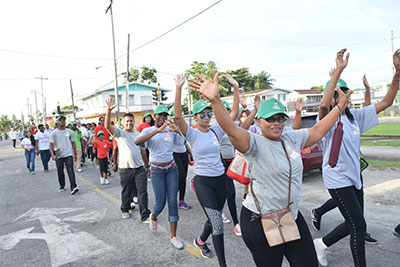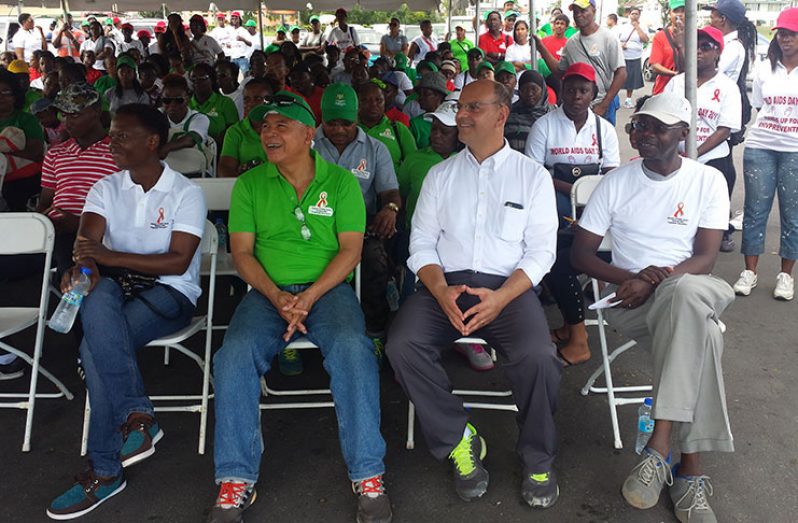WORLD AIDS Day is Thursday, December 1, and as Guyana seeks to bring the number of new HIV infections under control, local observances to usher in the momentous milestone kicked off in Georgetown Saturday with a spirited march around the capital, Georgetown,

culminating in an Inter-Faith Service and Rally at the Square of the Revolution.
Hundreds of enthusiastic youth led by key stakeholders participated in the march which moved off from Durban Square shortly after 06:00 hrs, purposefully wending their way through the streets of Georgetown, with a firm resolve to do whatever it takes to break the stranglehold of HIV and AIDS in Guyana.
Leading the march were Minister of Public Health Dr. George Norton; Head of UNAIDS (Guyana and Suriname) Dr. Martin Odiit; Assistant Public Affairs Officer Albert Razick,of the United States Embassy; and National AIDS Programme Secretariat (NAPS) Manager Dr. Rhonda Moore. They all addressed the rally following prayers by religious leaders and a few cultural items.
The keynote presentation was the World AIDS Day message delivered by Executive Director of UNAIDS, Michel Sidibe, and read to the forum by Dr. Martin Odiit.
Winning the War Against AIDS
The statement began thus: “…we stand in solidarity with the 78 million people who have become infected with HIV, and remember the 35 million who have died from AIDS-related illnesses since the first cases of HIV were reported.”
Noting that the world has committed to end the AIDS Epidemic by 2030 as part of the Sustainable Development Goals, the UNAIDS Executive Director said: “We are seeing that countries are getting on the fast track – more than 18 million people are now on life-saving HIV treatment and many countries are on track to virtually eliminate HIV transmission from mother-to-child.”
He added: “We are winning against the AIDS epidemic.” However, he expressed concern that progress is not being seen everywhere. Two areas of concern he cited are, “the number of new HIV infections is not declining among adults” and “young women being particularly at risk of becoming infected with HIV.”
He pointed to the transition to adulthood, as being a particularly dangerous time for many young women facing the challenges of HIV, exemplified by the young women in Sub-Saharan Africa. “They face a triple threat: a high risk of HIV infection, low rates of HIV testing and poor adherence to HIV treatment.”
Dangers of HIV Co-infection
The UNAIDS Executive Director also highlighted the dangers of co-infections of People Living with HIV (PLHIV), which he said are at risk of putting the 2020 target of fewer than 500,000 AIDS-related deaths out of reach. Examples of such infections are tuberculosis (TB), cervical cancer and hepatitis B and C. In 2015, TB caused about a third of AIDS-related deaths, while women living with HIV are at four to five times greater risk of developing cervical cancer.
To this end, he said that “taking AIDS out of isolation remains an imperative if the world is to reach the 2020 target.”
Over-50 danger
The UNAIDS Executive Director pointed out that with access to treatment, People Living with HIV are living longer, hence investing in treatment is paying off. He however cautioned that people older than 50 who are living with HIV (including people who are on treatment), are at an increased risk of developing age-associated HIV non-communicable diseases, affecting HIV disease progression.
“Whatever our individual situation may be, we all need access to the information and tools to protect us from HIV and to access antiretroviral medicines, should we need them. A life-cycle approach to HIV that finds solutions for everyone at every stage of life can address the complexities of HIV. Risks and challenges change as people go through life, highlighting the need to adapt HIV prevention and treatment strategies from birth to old age,” the Executive Director concluded.
Solid U.S. support
Representative of the U.S. Embassy, Mr. Albert Razick, alluding to the U.S.-Guyana collaboration in the fight against HIV/AIDS, said that the President’s Emergency Fund for AIDS Relief (PEPFAR) has been working with Guyana since 2004 to facilitate Access, Prevention, Care and Treatment Programmes, noting that American tax dollars have been able to make it highly possible to maximise these initiatives.
Mr. Razick assured that PEPFAR stands firmly by those who are affected by HIV-AIDS. He said when persons within a community are stigmatised or unable to access services due to discrimination, their human dignity, and indeed that of the entire community is threatened. Mr. Razick assured that the U.S. Embassy will continue to work with the government and people of Guyana to achieve an AIDS-free generation in Guyana.
The NAPS Director, Dr. Moore, noted that this year marks 29 years for Guyana in the fight against HIV/AIDS and said that it is a moment to reflect on our achievements, remember the 35 million people worldwide who have died as a result of AIDS, and the 36.1 million who are currently living with HIV/AIDS.
Dr. Moore said that Guyana had committed some three years ago to the UNAIDS 90-90-90 goal, which includes 90% of persons living with HIV receiving therapy by 2020.
Over 7,000 Guyanese Living with HIV
The NAPS Programme Manager said to date, it is estimated that over 7,000 Guyanese are living with HIV/AIDS and over 5,600 have been linked to a care and treatment facility, with more than 85 per cent receiving antiretroviral treatment (ART).
Additionally, it is estimated that more than 200 people die annually from AIDS- related illnesses. She said that the trends are revealing that there has been a gradual decline in the number of new AIDS cases over the past five years and that men are more affected than women. Also, that persons between the ages of 25 to 49 continue to account for most of the new infections. But more startling, the programme manager admitted that Guyana is also seeing an increase in the number of youths affected.
Grave concern
Minister of Public Health, Dr. George Norton, said that in Guyana, whilst adult HIV prevalence at the end of 2015 stood at 1.5 per cent, statistics for the period January to June, 2016 revealed that 1.9 per cent of young people aged 15-24 are living with HIV.
“This is a matter of grave concern for the government of Guyana, and we will be examining the possibility of introducing HIV/AIDS Counselling and testing services in secondary schools,” Dr. Norton said.
Minister Norton said that while HIV continues to be a major global public health issue, with some 36.7 million people globally living with HIV at the end of 2015, Guyana has achieved remarkable progress in the fight against HIV and AIDS. “The country has demonstrated a steady decrease in the number of AIDS cases and the number of AIDS-related deaths” Dr. Norton concluded.




.png)









